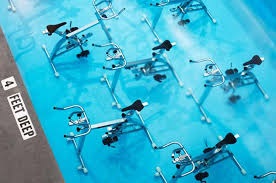
Foam roller therapy is also often called self-myofascial release. It has been shown to improve range of motion in the knee and hip, and to ease muscle soreness after exercise. Myofascial release comes from a theory that pressure from the rollers breaks up tight spots in muscles and the connective tissue that surrounds them, the fascia. In combination with regular stretching, using a foam roller can be more effective in improving flexibility.
The foam roller should not replace proper stretching, warming up and cooling down, but it can be used as a tool to limit soreness and tightness through increased blood flow and flexibility. By using the roller, you can help to also avoid injuries. The iliotibial band (IT band), the band that runs on the outside of the leg from the hip to just below the knee is one of the areas in the body that can be prone to injury. By rolling the foam roller on the side of the leg (slowly back and forth) towards the top of the leg, specifically where the quad where it meets the IT band it will help to increase blood flow and circulation, aiding in healing and preventing injury.
Here are 4 Foam Roller Stretches to try:
Lower Back Pain
Looser hamstrings will help with back pain. Sit on a foam roller with your legs stretched out. Support yourself with your hands on the floor behind you. Position yourself so that the roller is directly under your hamstrings. Slowly roll forwards and back from the base of your glutes to the bend in your knee for approximately 30 seconds.
Runner’s Knee
Roll your iliotibial band (the muscle on the outside of your leg from your hip to your knee). Lie on your side and slip the roller under your thigh. Cross your other foot over and put it on the floor. Roll back and forth for 30 seconds from the bottom of your hip to just above your knee.
Tendonitis
Tight quads can tug on your patellar tendons, causing pain around your knees. Lie on your stomach with the roller placed under your thighs. Holding the body straight, roll yourself back and forth from hip to mid-thigh for 30 seconds.
Upper Back Pain
Lie on your back and place the foam roller beneath your neck, near your shoulder blades. Your feet and backside should be on the ground and your hands behind your head. Brace your abs and slowly work the roller for 30 seconds up and down from your shoulder blades to your middle back (not your lower back).
If you add the foam roller in combination with static stretching you will notice results. Massage your own muscles and boost your performance with a foam roller. Have your trainer work it into your warm up and post workout.
For more articles go to http://lifesportfitness.lifestyleezine.com

 Underwater cycling or aqua cycling is an underwater workout that is starting to make an appearance in Europe and North America. Underwater cycling brings the stationary bike into the pool. Before making a splash in recreation centers around the world, it was used as a form of physical therapy for injured athletes. Most people know classic cycling from their fitness studio: several stationary bicycles are arranged in a circle. In the front sits the trainer who gives instructions against the background of motivational music. The participants simulate cycling up and down mountains and valleys, and cycle seated or standing. This sport is however not suitable for everyone because it puts a lot of strain on the joints. If you ‘shift’ the bicycle into the water, everything looks quite different. The motion sequences are especially gentle because of the effect of the water and are even more fun. Special water bikes have been developed for this that weigh a little more and don’t rust.
Underwater cycling or aqua cycling is an underwater workout that is starting to make an appearance in Europe and North America. Underwater cycling brings the stationary bike into the pool. Before making a splash in recreation centers around the world, it was used as a form of physical therapy for injured athletes. Most people know classic cycling from their fitness studio: several stationary bicycles are arranged in a circle. In the front sits the trainer who gives instructions against the background of motivational music. The participants simulate cycling up and down mountains and valleys, and cycle seated or standing. This sport is however not suitable for everyone because it puts a lot of strain on the joints. If you ‘shift’ the bicycle into the water, everything looks quite different. The motion sequences are especially gentle because of the effect of the water and are even more fun. Special water bikes have been developed for this that weigh a little more and don’t rust. If you workout or have played fun sports, you are most likely familiar with icing an injury. While ice is the standard protocol for some injuries, you are probably also common with using heat to ease tense muscles. So when should you be using a cold compress and when must you be using heat? The following article is a basic guide to help you treat your injury effectively.Pain after an injury or overuse of an area of your body is mostly a result of swelling or inflammation of the affected tissue whether it is bone, muscle, ligament or tendon.
If you workout or have played fun sports, you are most likely familiar with icing an injury. While ice is the standard protocol for some injuries, you are probably also common with using heat to ease tense muscles. So when should you be using a cold compress and when must you be using heat? The following article is a basic guide to help you treat your injury effectively.Pain after an injury or overuse of an area of your body is mostly a result of swelling or inflammation of the affected tissue whether it is bone, muscle, ligament or tendon.